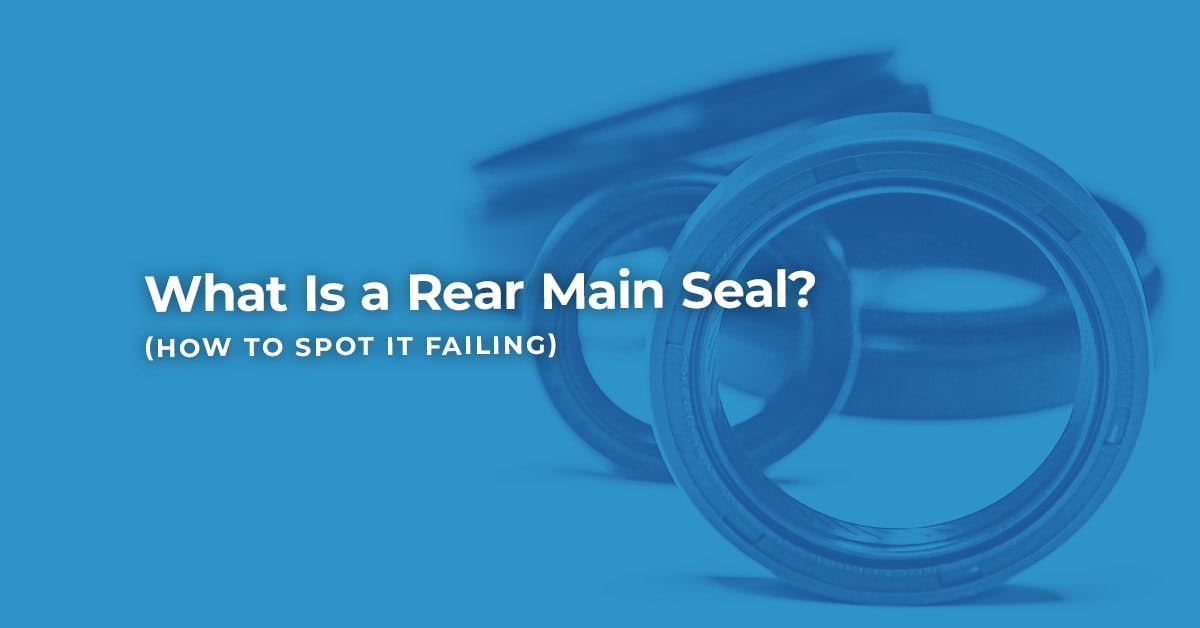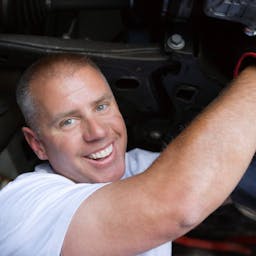The rear main seal is essential for keeping oil in your engine and preventing it from leaking out of the crankshaft and into the transmission.
This location typically requires removing the transmission to access it, which can lead to a costly repair bill.
Even though the seal itself is a very inexpensive part, the overall repair cost will set you back £500 to £800, on average.
If your car suffers a rear main seal failure, you might be able to avoid a full repair - depending on the damage suffered.
Read on and find out what a rear main seal is, the signs of failure, and the replacement and repair options for worn and leaking rear main seals.
Page Contents
Summary
The rear main seal is essentially a rubber gasket that seals the rear of the crankshaft, exiting the engine and connecting with the transmission.
The crankshaft is supported by main bearings, which receive oil to lubricate the crankshaft.
The rear main seal prevents oil from getting out of the crankcase and into the transmission housing.
The gasket is made of rubber and can easily deteriorate, leading to oil leaks. These leaks can be caused by:
- Normal wear and tear
- Worn main bearings
- A bad PCV valve
- Low oil levels
- Crankshaft problems
- Transmission alignment problems
Fortunately, a bad rear main seal will only result in an oil leak - it usually doesn't have any severe or catastrophic issues outside of the leak.
However, oil leaks can lead to low oil levels, which can cause more serious engine problems.
Look out for warning signs from your rear main seal and act as soon as you notice a leak.
What Is a Rear Main Seal?
A rear main seal is often called a rear crankshaft seal, as it is located on the rear side of the engine where the crankshaft connects to the transmission.
The seal prevents engine oil from leaking out of the crankshaft.
Your car puts the crankshaft under a lot of force.
It holds the pistons and is connected to the flywheel and the pulleys that power all the engine accessories.
Due to the force and stress put on the crankshaft, it has some main bearings to support it.
These main bearings hold the crankshaft in place and allow it to rotate, as well as allowing oil to pass to the crankshaft.
This keeps it lubricated and avoids friction damage.
The rear main seal sits outside the rear main bearing to hold the oil in.
The seal is typically made of silicone or rubber and wears down from friction between the seal and the crankshaft.
If an engine runs on low oil levels, it can starve the rear main seal of oil, which will cause excess friction between the seal and the crankshaft, deteriorating the seal and resulting in an oil leak.
What Happens When the Rear Main Seal Fails?
Failure of the rear main seal usually results in an oil leak from the camshaft into the transmission bell housing.
While the seal generally doesn't cause any major or catastrophic engine problems, the oil leak it causes can potentially lead to more serious issues.
If the seal is badly worn, it can cause a fast oil leak, quickly draining the reservoir.
This can lead to severe internal engine failures and expensive repairs.
More commonly, the rear main seal tends to deteriorate over time and will usually start as just a small oil leak that gets gradually larger.
While we recommend repairing a bad seal as soon as possible, it isn't necessarily an urgent repair since it results in a small oil leak.
In a best-case scenario, replacing the rear main seal requires removing the transmission.
Nevertheless, depending on the location of the oil pan and the direction your engine is mounted, you may need to remove the oil pan to be and/or the whole engine.
Therefore, replacing the seal can be a costly repair job that you might not always be able to address immediately.
Symptoms of Rear Main Seal Failure
There are three common signs of a bad or failing rear main seal:
- Oil leak where the transmission connects to the engine
- Frequent low oil light from constant oil loss
- Oil stains on your driveway
Since seal failure results in an oil leak, the most common symptoms are low oil levels and stains left behind from your vehicle.
However, oil leaks can come from various parts of an engine, like the oil filter housing, valve cover gasket, PCV, head gasket, and so on.
Diagnosing a rear main seal failure can be tricky.
The telltale sign of a rear main seal oil leak is the leak's location.
Oil leaks from a rear main seal will always come from the rear side of the engine, right where it bolts up to the transmission.
Therefore, the easiest way to detect it is to check the rear of the engine for any visible signs of a leak.
Causes of Rear Main Seal Oil Leaks
Normal wear and tear can cause issues with the rear main seal, and certain problems can even lead to a leak or failure.

While some failures are natural, others are not.
Natural Wear and Tear
As the crankshaft is constantly rotating against the rear main seal, it is common for the seal to wear down over time and begin to leak.
When this happens, you will typically notice a small leak gradually getting more significant.
The other causes usually result in a bigger leak that expands more quickly.
So if you have a small and gradual leak, it is likely from normal wear and tear over time.
Preventative maintenance is the best way to prolong the life of the rear main seal.
This includes frequent oil and filter changes and topping up with engine oil.
Worn Main Bearings
The main bearings hold the crankshaft in place, allowing it to rotate in a fixed position.
Main bearings are made of metal, as is the crankshaft, and can wear down from the friction of the crankshaft.
When these bearings wear down, it can create some 'slop' in the crankshaft, allowing it to move or wiggle slightly.
This then puts excess force on the main seal, which can cause it to deteriorate quickly.
Unfortunately, bad main bearings will also lead to several performance-related issues and require a new bearing and possibly a new crankshaft.
Due to the location of the bearings, it will require the engine to be taken apart, making it a costly repair.
Low Oil Levels
When an engine runs on low oil levels, various components are starved of oil and lubrication.
This results in more friction and heat inside the engine which then takes a toll on the rubber seal causing it to wear down and leak.
Low oil levels can also cause a number of other issues, like worn main bearings, so it is essential to keep your engine oil topped up.
Clogged PCV Valve or Failure
Engines produce what is called "blow-by gasses" which occur when oil, gas, and exhaust fumes make it past the piston rings and end up in the crankcase.
The PCV valve is responsible for venting this bad gas back into the intake tract, where it is reburned.
This reduces emissions and releases the pressure it creates in the crankcase.
A clogged PCV valve will prevent the blow-by gasses from venting out of the crankcase, which causes pressure to build inside the engine.
The excess pressure puts outward forces on the rear main seal, which can cause it to slip out of place, breaking the seal it creates between the crankshaft and the transmission.
This will ultimately result in an oil leak.
Crankshaft or Transmission Misalignment
A misaligned crankshaft won't rotate in a perfect circle, putting excess stress on the rear main seal.
Additionally, the input shaft on manual transmissions or flex plate on automatic transmissions can be misaligned or damaged, putting stress on the seal and causing it to fail.
These issues are less common - unless you have recently had a transmission or crankshaft replacement resulting in a potential misalignment during the installation.
Can You Drive with a Rear Main Seal Leak?
If you think that your car's oil level is too low, then you should stop driving the vehicle.
Driving with a rear main seal leak is dangerous, and you could cause permanent engine damage if you continue to do so.
Rear Main Seal Replacement Options
The simple answer to a rear main seal leak is to replace the part.
However, as we've discussed, this can be very expensive.
If you are looking for a temporary solution until you can afford a complete fix or if your car isn't valuable enough to justify the repair costs, you have a few other impermanent options.
We would strongly recommend getting a professional opinion from a garage to diagnose the cause of the issue before attempting any of the DIY fixes below.
Use an Oil Additive
Oil system additives - such as BlueDevil's Rear Main Sealer - are added directly to your engine's oil to repair gasket and seal leaks.
The additive creates a chemical reaction that causes the rear main seal to expand, stopping the leak.
It works on any rubber seal, whether cracked, dried, or deformed.
You can use it more than once if the seal continues to wear down and leak. This is an effective short-term solution but will not permanently fix the issue.
However, for older and less valuable vehicles, it is a great £15 fix compared to the cost of replacing the seal.
Use a Thicker Engine Oil
Using thicker engine oil will slow the rate of any oil leak, as thicker oil has a harder time getting through small cracks.
Switching from something like 5w-20 to 10w-30 can drastically reduce the rate of any oil leaks.
Again, this temporary fix can be used with a seal repair additive, as mentioned above.
Above are only temporary methods to deal with the rear main seal failure.
In the long run, we recommend booking an appointment with a local garage.
A professional garage will carry out an inspection to find the problem and will provide you with a transparent quote for a rear main seal replacement if required.
Compare garages near you instantly with BookMyGarage to find the best deals.
You can see instant prices and availability, and won't have to pay until the work is complete.






